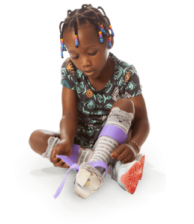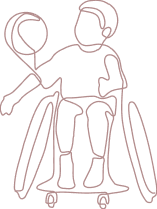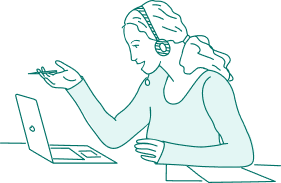What is cerebral palsy?
Cerebral palsy is a group of disorders that affects movement, muscle tone, and coordination. Different parts of the body can be involved depending on the severity and type of CP.
Many cases of cerebral palsy are linked to complications during childbirth, but the condition is usually not diagnosed until a baby is 12–24 months old. This delay can leave new parents unsure why something feels off after a difficult delivery.
Watch our short video of cerebral palsy to learn more.
Learn more about cerebral palsy and what to do if you suspect your child’s condition could have been prevented. View Transcript.
Duration: 1 min 04 sec
Cerebral palsy is a condition that affects how some people move and learn. It's caused by damage to the developing brain before or after birth.
According to the Centers for Disease Control and Prevention, about one out of every 345 children in the United States has cerebral palsy.
Sometimes, cerebral palsy can happen because of a preventable mistake by a doctor or hospital during childbirth. This is called medical malpractice.
If you think your child has cerebral palsy because of medical malpractice, you might be able to pursue life-changing compensation for their treatment. An experienced birth injury lawyer can explain your rights and help get you the support you need.
You may have legal options if your child’s cerebral palsy was caused by medical malpractice. Connect with the team at Cerebral Palsy Guide today for a free, no-obligation case review.
Cerebral palsy has no cure, and long-term care needs can be far more than most families could ever prepare for. If medical mistakes contributed to your child’s condition, cerebral palsy financial assistance may be available, so your child can live their best possible life.
Our network of cerebral palsy lawyers has secured over $1 billion for families impacted by birth injuries, including CP.
Find out if we can help your family, too. Get a free case review right now.
10 quick facts about cerebral palsy: 2025 update
- Cerebral palsy affects about 1 in 323 children.
- Most cases are congenital, meaning the brain injury occurred before or during birth.
- CP does not worsen over time, but symptoms can change as a child grows.
- Spastic CP is the most common type, affecting up to 85% of children.
- About 50% also have epilepsy, requiring long-term management.
- Premature birth and low birth weight remain 2 of the strongest known risk factors.
- More than half of children with CP can walk independently, though mobility varies.
- Speech and language challenges affect over 75% of children with cerebral palsy.
- Cerebral palsy symptoms in babies video clips can now be analyzed using AI tools to spot CP earlier.
- About 1 in 5 babies with necrotizing enterocolitis (NEC), a severe intestinal disease, later develop CP.
In September 2025, University of Melbourne researchers announced Baby Moves VIEW, an app that may help with diagnosing cerebral palsy up to 1.5 years earlier.
Early signs of cerebral palsy in babies
Symptoms of cerebral palsy often appear during a baby’s first months of life, usually as delays in reaching milestones like lifting the head, rolling over, sitting, or crawling.
Parents may notice these cerebral palsy symptoms:
- Difficulty sucking, swallowing, or feeding
- Excessive fussiness or inability to soothe
- Favoring one side of the body
- Jerky, exaggerated, or involuntary movements
- Stiff or floppy muscle tone
- Trouble grasping objects or bringing hands to the mouth
- Unusual posture or difficulty holding up the head
- Vision or focusing difficulties
- Weak or absent reflexes
These signs do not confirm cerebral palsy on their own, but they may indicate a need for medical evaluation.
If you're concerned about your baby’s development, or if something feels off after a difficult birth, consider speaking with our experienced labor and delivery nurses. It’s always free to talk with our team.
What causes cerebral palsy in babies?
The main cause of CP is damage to the fetal or infant brain. Although the exact cause of brain damage can be difficult to pinpoint, several factors are linked to the condition.
Common causes of cerebral palsy and risk factors include:
- Bacterial and viral infections, such as meningitis
- Bleeding inside the brain (intracranial hemorrhage)
- Brain damage from periventricular leukomalacia (PVL)
- Head injuries sustained during birth or within the first few years of life
- Kernicterus (brain damage from severe jaundice that goes untreated)
- Lack of oxygen to the brain (asphyxia) before, during, or after delivery
- Nuchal cord complications (umbilical cord wraps around a baby’s neck)
- Prenatal exposure to drugs or alcohol
Generally, if the brain is damaged within the first 5 years of life, it may not develop properly. Damage to the parts of the brain that control motor function can cause children to struggle with posture, balance, and movement.
Cerebral palsy caused by medical negligence
Some children develop cerebral palsy as a result of a birth injury caused by medical malpractice. These CP cases stem from inadequate care from medical professionals during the birthing process.
Examples of medical negligence that can lead to cerebral palsy include:
- Failing to prevent or respond to hypoxic-ischemic encephalopathy (HIE)
- Ignoring changes in fetal heart rate
- Mismanaging umbilical cord issues, which can cut off oxygen to the baby
- Neglecting infections that required timely monitoring or treatment
- Not performing a medically advisable cesarean section (C-section)
- Improperly using delivery tools like vacuum extractors and forceps
Medical professionals are trained to provide high-quality care and make lightning-fast decisions to keep mothers and babies safe. Those who fail to do so should be held responsible.
However, medical providers often downplay their role in causing harm or even deny it altogether. Experienced legal professionals can help you understand what may have happened to your child.


"Experienced CP lawyers have handled many of these cases for families like yours and know the tactics hospitals use to hide mistakes, make low offers, or deny responsibility."
— Ricky LeBlanc, cerebral palsy lawyer
If you believe a preventable birth injury played a role, a top CP lawyer in our network may be able to fight for you. Get a free case review right now.
Diagnosing CP
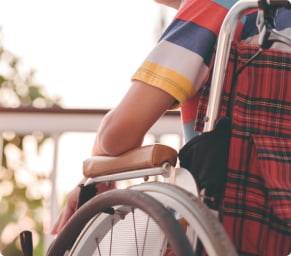

Although parents and caregivers may be the first to notice signs of cerebral palsy in infants, doctors often hesitate to make a cerebral palsy diagnosis until further symptoms can be observed as the child grows.
CP is most often diagnosed between 12 and 24 months, but some children with milder symptoms may not be diagnosed until age 3 to 5. Imaging tests are often used to look for brain injury and help confirm the diagnosis.
1. Developmental monitoring
This involves tracking a child's growth and development on an ongoing basis at well-child visits.
Developmental monitoring includes discussing any concerns with parents, reviewing the child's developmental history, and observing the child's movements.
"Cerebral palsy usually isn’t diagnosed at birth, even if there was a lack of oxygen. It’s often identified later when a child misses developmental milestones.”
— Kristin Proctor, Cerebral Palsy Guide on-staff registered nurse
2. Developmental screening
This type of screening involves short tests to check for developmental delays, such as motor or movement delays. These can be parent-completed questionnaires or tests administered by the doctor.
The American Academy of Pediatrics (AAP) recommends that developmental screenings be performed at 9 months, 18 months, and 24 or 30 months.
Additional screenings can be done at any time concerns about a child's development arise.
3. Medical evaluations
These evaluations are detailed and focus on diagnosing developmental disorders, specifically examining motor skills, muscle tone, reflexes, and posture.
Evaluations are conducted by cerebral palsy specialists like developmental pediatricians, child neurologists, or pediatric rehabilitation doctors.
Medical and imaging tests that can help diagnose cerebral palsy include:
- Computed tomography (CT) scans
- Cranial ultrasounds
- Electroencephalograms (EEG)
- Genetic or metabolic testing
- Magnetic resonance imaging (MRI) scans
Parents can begin managing their child’s condition and start any necessary treatment once a diagnosis is made.
What are the types of cerebral palsy?
There are several types of cerebral palsy, and each is characterized by the location of the brain injury. Symptoms can vary depending on where and how badly the brain was damaged.
The 5 types of cerebral palsy are:
- Ataxic cerebral palsy: This type is caused by damage to the cerebellum, resulting in motor control and movement issues.
- Athetoid/dyskinetic cerebral palsy: Caused by damage to the basal ganglia and/or cerebellum, this condition results in fluctuating muscle tone and involuntary movements.
- Hypotonic CP: This rare type, also connected to cerebellum damage, is characterized by floppy muscles, excess flexibility, and poor mobility.
- Mixed CP: Multiple areas of brain damage can lead to patients having more than one type of CP.
- Spastic CP: This is due to motor cortex damage and causes tight muscles and jerking movements. Severe forms include spastic quadriplegia, affecting all 4 limbs.
Doctors can perform tests to determine the type of CP a patient has. According to the Centers for Disease Control and Prevention (CDC), diagnosing the condition as early as possible is important for the child's long-term health and development.
Was your child recently diagnosed with cerebral palsy? You may qualify for financial assistance. Get your free case review right now.
Cerebral palsy coexisting conditions
Damage to the developing brain can cause health complications that are not a direct result of CP. As a result, babies with cerebral palsy may also experience coexisting conditions.
Conditions that may occur alongside cerebral palsy include:
- Attention-deficit hyperactivity disorder (ADHD)
- Chronic pain
- Epilepsy
- Intellectual disabilities
- Mental health disorders
- Spectrum disorders like autism
- Speech problems
- Vision or hearing impairments
Understanding and addressing these coexisting conditions is crucial for providing comprehensive care and helping a child with CP reach their full potential.
Cerebral palsy treatment options
A comprehensive cerebral palsy treatment approach can greatly improve quality of life. CP treatment focuses on nurturing a child’s abilities to reduce symptoms and encourage independence.
Is cerebral palsy curable?
Cerebral palsy is not curable, but treatments can help improve a child’s movement, muscle control, and everyday life.
Find out more about different cerebral palsy treatments below.
Medication
Cerebral palsy medication helps manage symptoms, especially those related to muscle tone and movement difficulties.
Common medication categories include:
- Anticholinergics for involuntary movements
- Anticonvulsants for seizures
- Botulinum toxin injections for targeted spasticity
- Intrathecal baclofen pumps for severe spasticity
- Muscle relaxants for tight or stiff muscles
- Pain relievers for discomfort
- Reflux medications for GERD
- Stool softeners for constipation
Your child's doctor will prescribe the cerebral palsy medications most likely to help with their specific CP symptoms.
Therapy
There are many different therapy options to help treat cerebral palsy symptoms. Therapy can be used to improve mobility and brain function.
These are the 4 main types of therapy for CP:
- Physical therapy to reduce stiffness and improve mobility, balance, and strength
- Occupational therapy to build fine motor skills, daily living skills, and independence
- Speech therapy to support communication, feeding, and swallowing
- Alternative therapy, like aquatic and music therapy, to build confidence and emotional regulation
Most children with CP benefit from multiple therapies. A customized treatment plan can be created based on your child's symptoms.
Surgery
Cerebral palsy surgery may be recommended when stiffness, contractures, or bone alignment issues limit movement or cause pain.
Surgical options for CP may include:
- Interventions to support balance and alignment
- Procedures to correct contractures, hip issues, or foot deformities
- Selective dorsal rhizotomy (SDR) for severe spasticity
Muscles, tendons, bones, and nerves are operated on to improve movement in different areas of the body. These procedures can make mobility easier and prevent long-term orthopedic problems.
Assistive devices
Specialized assistive devices can help individuals with CP who experience issues with communication, hearing, and vision.
Types of assistive devices for CP include:
- Communication devices and speech-generating tools
- Eye-tracking systems
- Hearing aids or cochlear implants
- Visual aids like glasses or magnifiers
Using assistive devices can greatly improve communication, mobility, and independence for people with cerebral palsy.
Mobility aids
Cerebral palsy mobility aids help children move safely and comfortably throughout their daily lives. These tools are often adjustable, allowing them to grow with your child.
Types of mobility aids for CP include:
- Manual or motorized wheelchairs
- Orthotics for gait and muscle support
- Power scooters
- Walkers, canes, and crutches
Treatment for CP can be expensive, and insurance doesn’t usually cover everything. Financial compensation from a cerebral palsy lawsuit can significantly ease the burden.
This money can ensure access to the best available treatments, support your child's development, and improve their quality of life.
Get a free case review right now to find out if you may be eligible.
Research and advances in cerebral palsy treatment
CP research continues to move toward earlier diagnosis, better mobility, and safer long-term symptom management. While there is no cure, new tools and therapies may help children gain more independence as they grow.
Here are 5 key areas of progress:
-
- Early detection tools, including improved imaging and emerging AI- and video-based assessments that can help identify CP much earlier than traditional screening
- Stem cell research, which is being studied for its potential to repair damaged brain tissue
- Improved neuroimaging, helping doctors understand how brain injuries develop and how early intervention may help
- Advances in rehabilitative therapy, including robotic-assisted movement training and functional electrical stimulation
- More targeted spasticity treatments, including refined Botox® techniques and surgical approaches like selective dorsal rhizotomy
These developments offer hope for families by improving long-term mobility, communication, and overall quality of life for children with CP.
Cerebral palsy life expectancy
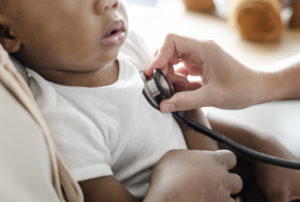

Most children with CP live well into adulthood, and many have a typical life span. CP is not a progressive condition, but a child’s prognosis (long-term outlook) can vary based on their specific symptoms and care needs.
Factors that may influence life expectancy include:
- Eating and swallowing difficulties
- Intellectual disabilities
- Mobility limitations
- Respiratory or musculoskeletal problems
- Seizures
With the right medical care, therapy, and support, many people with CP live long, full lives. Early intervention and ongoing management can help reduce complications and improve overall quality of life.
If your child has CP, download our FREE Cerebral Palsy Guide to get the information you need.
Living with cerebral palsy
CP presents unique challenges, but it also opens doors to a world of resilience, adaptability, and community support.
Individuals with cerebral palsy and their families navigate daily life with strength, discovering innovative ways to participate in activities, achieve personal goals, and contribute meaningfully to their communities.


"Throughout every stage of my life, my parents gave me the tools and encouragement I needed not to let my disability define my ability."
— Amie Kroessig, Patient Advocate and Outreach Coordinator living with CP
Advances in medical treatments, therapy, and assistive technologies have significantly improved quality of life, enabling more independence and involvement.
A network of resources, from specialized health care professionals to supportive online communities, empowers those affected by CP to achieve their dreams.
Embracing these resources and focusing on abilities rather than limitations fosters a positive outlook and a vibrant, engaging life experience.
Get help paying for your child’s care
Many families feel overwhelmed and unprepared to pay for the costs of care that come with raising a child with CP. Thankfully, there are many options to help families cover treatment costs and other expenses.
Cerebral palsy financial assistance may be available to alleviate any burdens placed on your family, so you can focus on getting quality care for your child.
If you suspect your child’s CP could have been avoided, you may have legal options. A cerebral palsy settlement could provide the financial support your family needs and deserves.
Cerebral Palsy Guide partners with top lawyers and law firms who can help families in all 50 states. Together, they have recovered over $1 billion for families affected by preventable birth injuries, including CP.
Call our trained patient advocates at (855) 220-1101 or get a free case review right now to find out your options.


